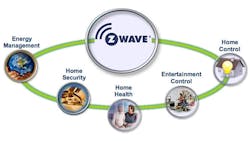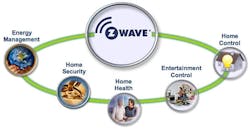Mark Walters Talks About The Z-Wave Alliance
Z-Wave and Zigbee are two popular, low power, wireless protocols for embedded systems. Z-Wave has done especially well in home automation but it can be used for many other applications as well (see figure above). A Z-wave network can have up to 232 nodes.
I recently spoke with Mark Walters, President and Chairman of the Z-Wave Alliance. Z-Wave Alliance members provide a wide range of hardware, software and services based on Z-Wave standards.
Some Z-Wave technology essentials include:
- Low-powered RF communications technology that supports full mesh networks without the need for a coordinator node
- Operates in the sub-1GHz band; impervious to interference from Wi-Fi and other wireless technologies in the 2.4-GHz range (Bluetooth, ZigBee, etc.)
- Designed specifically for control and status apps, supports data rates of up to 100kbps, with AES125 encryption, IPV6, and multi-channel operation
- MAC and PHY are described by ITU-T G.9959 specification
- Full interoperability through layer 5 with backwards compatibility to all versions.
- Successfully bridged and trialed with OpenADR, SEP 1, SEP 1.1 and other Smart Energy protocols.
- Shares the same position in the NIST/SGIP Catalog of Standards as the IEEE 802.11 and 802.15 and 802.16 families
Wong: From a broad perspective, how has Z-Wave become the world's most broadly adopted wireless protocol for control and automation products and services—essentially, the "go to" platform for the smart-home market?
Walters: Z-Wave has been so successful because it works. It works from a technical standpoint, allowing stable networks of several hundred devices to occupy a building or home with solid communications links while keeping energy requirements low enough so that devices like battery-powered door locks and thermostats can go years on a single set of batteries.
It works in that we have been able to maintain a strong standard and certification program such that there is industry-leading cross brand, cross-manufacturer, product-level interoperability. Consumers—whether service providers, security installers or end consumers—have their choice of many different companies for the same type product from the industry’s leading manufactures. An great example would be door locks; a consumer can buy a Z-Wave certified door lock from Kwikset, Baldwin, Yale, or Schlage, and they are all interchangeable from a communications standpoint.
It works because we have maintained complete backwards compatibility across 10 years market experience. We have never stranded a product; as a result, consumers are assured a "future-proof" solution that will never become obsolete.
It works because Z-Wave has some of the most cost-effective, and easiest-to-implement, hardware and software solutions in the industry, making product development simple and fast. This allows companies that are not experts in RF communications—but are experts in things like locks, thermostats and lighting controls—to make their products smart utilizing Z-Wave technology.
This file type includes high resolution graphics and schematics when applicable.
Wong: How does Z-Wave plan to withstand challenges from established protocols like Zigbee, Insteon, and X10, along with relative newcomers like Wi-Fi, Bluetooth and SHP?
Walters: Mostly the answer is in the question above. In addition, Z-Wave isn’t standing still. We have recently launched a new certification program called Z-Wave Plus. Z-Wave Plus products are fully backwards-compatible with classic Z-Wave products; however the Z-Wave Plus badge assures consumers that they are purchasing products with the latest features and enhancements that the technology has to offer.
Z-Wave enjoys the support of over 250 industry leading manufacturers worldwide with an ecosystem of over 1,100 interoperable products. We have a 10-year headstart on the above-mentioned technologies and are not slowing down, adding new manufacturers, new products and new user-friendly features.
Also, we have just released a new technology called Z I/P or “zip.” Z I/P is a bridging technology where every Z-Wave device—all 25 million in circulation today, and all to come in the future—can automatically be assigned an IPv4 or IPv6 address and become directly addressable from the Internet of Things (IoT).
Wong: How will Z-Wave technology drive innovation among smart device manufacturers?
Walters: Z-Wave technology makes it easy and cost-effective to add “smarts” to smart devices. We take care of the commutations networking, the standardization, the certification, the promotion and the ecosystem development so smart device manufacturers can focus on what they do best: build devices with feature sets that meet the needs of the market. We have continuously evolved Z-Wave technology over the past 10 years, ensuring that we can deliver the performance and features the market requires while maintaining strict adherence to cross- brand, cross-manufacturer, product-level interoperability and backwards compatibility.
Wong: You've announced recent technological developments like ZIPR, expanded bandwidth, and Z-Wave Plus. What are some of the other Z-Wave technological advancements on the horizon?
Walters: There are some new SoC hardware platforms coming from silicon maker Mitsumi Corporation that will provide additional on-chip hardware support and extended memory that will further simplify the process of developing higher-value, more complex products. We are putting tremendous resources into supporting the smart device developer with better development tools and support to further decrease their time and cost to market. What's more, we will soon be launching predefined, standardized solutions for our partners to join in with Apple's HomeKit environment and with NEST’s development partnerships.
Wong: Talk about the relationship with Sigma Designs as one of two chip makers for Z-Wave home control technology. And why was Mitsumi brought on as a licensed, second-source supplier for Z-Wave 500 series wireless RF technology?
Walters: Sigma Designs is the licenser of the Z-Wave Technology and the primary supplier of SoC platforms used for smart-device creation. They just recently launched their 5th generation of Z-Wave SoC’s with greatly improved bandwidth, energy consumption, and memory -- all at lower cost. Mitsumi Corporation will provide a second source for these parts as well as offering offer additional SoC’s with expanded on-chip resources for higher-value, more complex products. Having two industry-leading SoC manufacturers supporting the market for Z-Wave SoC transceiver platforms further enriches the value of the Z-Wave technology to the smart device manufacturer.
Wong: Can you provide some performances statistics for the Z-Wave technology?
Walters: The Z-Wave protocol is an interoperable wireless RF-based communications technology designed specifically for control, monitoring and status reading applications in residential and light commercial environments. Mature, proven and broadly deployed (25 million products sold worldwide), Z-Wave is by far the world market leader in wireless control, bringing affordable, reliable and easy-to-use 'smart' products to many millions of people in every aspect of daily life.
Mark holds bachelor’s degrees in Biology and Chemistry from the University of California at Santa Cruz and a MBA from City University, Seattle.
About the Author
William G. Wong
Senior Content Director - Electronic Design and Microwaves & RF
I am Editor of Electronic Design focusing on embedded, software, and systems. As Senior Content Director, I also manage Microwaves & RF and I work with a great team of editors to provide engineers, programmers, developers and technical managers with interesting and useful articles and videos on a regular basis. Check out our free newsletters to see the latest content.
You can send press releases for new products for possible coverage on the website. I am also interested in receiving contributed articles for publishing on our website. Use our template and send to me along with a signed release form.
Check out my blog, AltEmbedded on Electronic Design, as well as his latest articles on this site that are listed below.
You can visit my social media via these links:
- AltEmbedded on Electronic Design
- Bill Wong on Facebook
- @AltEmbedded on Twitter
- Bill Wong on LinkedIn
I earned a Bachelor of Electrical Engineering at the Georgia Institute of Technology and a Masters in Computer Science from Rutgers University. I still do a bit of programming using everything from C and C++ to Rust and Ada/SPARK. I do a bit of PHP programming for Drupal websites. I have posted a few Drupal modules.
I still get a hand on software and electronic hardware. Some of this can be found on our Kit Close-Up video series. You can also see me on many of our TechXchange Talk videos. I am interested in a range of projects from robotics to artificial intelligence.
Mark Walters
President and Chairman
Mark has over 20 years experience in all aspects of electronic product solutions. He has held senior management roles in Engineering and Product Development for companies with products as diverse as high-end sound reinforcement, vehicular sensing and controls, premise wiring solutions and automated building controls. His specialties are RF Mesh Networks and Home Automation and Security. His passion is using technology to improve the lives of those that need assistance to make it through the day with comfort, safety and dignity.
Mark holds bachelor’s degrees in Biology and Chemistry from the University of California at Santa Cruz and a MBA from City University, Seattle.




